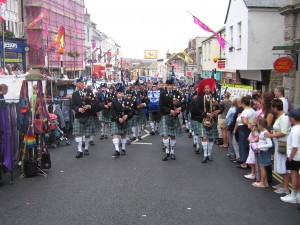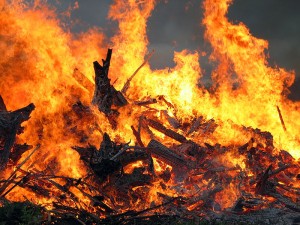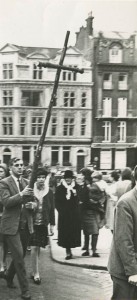Since we are getting close to the northern hemisphere Midsummer, I thought I would have a look at some aspects of Midsummer Heritage:
The Cornish language word for ‘Midsummer’ is Golowan. This was a time of celebrations and festivals in Cornwall, particularly connected to St John’s Eve (23rd June) and St Peter’s Eve (28th June); corresponding to a period marked by rejoicing, street fairs and festivals, particularly of bonfires, fireworks and processions.
If you follow some internet links, you soon discover that Golowan is a distinctly ‘Cornish’ activity. It is certainly used today to celebrate and re-inforce a sense of Cornish cultural identity. Golowan is a Cornish word; the festival and outdoor performance activities that are associated with it (such as Mazey Day in Penzance), are portrayed as distinctly ‘Cornish’; a day to wave the black and white flags of St Piran; a day to do the Trelawny Shout; steeped in a distinctly Cornish and Celtic heritage.
But just how useful is it to describe this event as ‘Cornish’? Afterall, the calendar dates are those of Christian saints (John and Peter), who have an international standing: While fishing has long been a prominent industry in Cornwall (and one very important to the self-image of many people who describe themselves as ‘Cornish’), St Peter is celebrated by many fishermen across Europe and beyond; while St John’s Eve is also prominently celebrated with bonfires in many countries, with a particular public face in Scandinavia. These are international Christian festivals, not ‘Cornish’ in essential detail.
While these events were not essentially ‘Cornish’, however, it can be argued that, first: the continued to be celebrated for longer in Cornwall than elsewhere, with an (at times, perhaps) intermittent cultural memory of celebratory practice that stretches back many centuries. Secondly, of course, although these festivals are ostensibly ‘Christian’, they could also be marking the vestiges of a pre-Christian midsummer festival, which might not be ‘Cornish’ as such, but would seem to have the sort of ‘Celtic’ roots that is customarily assigned to ‘Cornishness’.
Golowan, therefore, has been revived and celebrated as an item of (Celtic and Cornish) ‘folk tradition’. It is an item of non-elite identity performance, group cohesion and communal heritage. This sounds very positive, and perhaps also points towards a wider tradition of carnivals and fairs – vernacular events that blur the boundaries of official and non-official; participant and audience, and which are celebrated as ‘authentic’, local and inclusive. Within Cornwall, such activities were noted in the 18th century by the local antiquarian, Dr William Borlase, as being of ‘Druid’ origin, hinting at a William Stukeley-style ‘British’ aboriginal Druid being conjoured up. But while for William Stukeley, the ‘British Druid’ represented a fairly elite aboriginal bulwark against continental Catholicism, more recent Druidic narratives have tended to suggest an anti-Establishment Pagan-Celtic folksiness that is very much locally embedded. Basically, there is a strong argument that such activities might genuinely possess quite ancient roots, and the very being of these sorts of activity often seems to (proverbially) stick two fingers up at the Establishment, akin to practices such as ‘rough music’, of masquerade, and a history of folk resistance. This line of thinking, to my mind at least, certainly broadens out the ‘Cornish essentialism’ that is often trotted out in the commentary of these events. Rather than being essentially ‘Cornish’, it rather suggests Cornwall as a place where these once-widely celebrated traditions lived on and survived. But how does this sit with other ‘Cornish’ traditions?
As a spiritual movement that seems to be strongly rooted in Cornwall, the Methodist Church is sometimes referred to as the ‘national church of Cornwall’. The strength of Methodism on Cornwall was certainly recognised in the earlier 20th century Cornish revival movement – as being anti-established Church (of England). But Methodism and non-conformity also has a slightly ‘severe’ image when it comes to interpreting the ancient remains of aboriginal ‘Druids’. This is often recounted in the naming of stone circles and megaliths: as ‘maidens’ (either numbered or ‘merry’) who were turned to stone for dancing (to the tune of ‘piper’ stones) on a Sabbath. More recently, the Cornish agenda seems to have shifted, from identifying with Methodism and Nonconformity, to a stronger association with Earth Mysteries and Pagan spirituality, and some scholars have invoked the term ‘Cardiac Celts’ for whom they characterise as middle class metropolitan ‘blow-ins’. Resonant with Stukeley’s Druids, this line of thinking sits very comfortably with the activities of Golowan and Mazey Day – but is an alignment of a fairly exclusive ‘ethnic’ sense of Celtic-Cornishness with a supposedly middle class set of earth mysteries enthusiasts really ‘anti-Establishment? Perhaps it can be said to ‘blur the boundaries’ between a vernacular and spontaneous sense of subversive revelry and a more sober expression of a desire to find a ‘sense of place’.
In some ways, this blurring also has resonance with another distinct practice of ‘Methodist’ tradition in Cornwall – that of parading and street procession. Every Chapel in Cornwall would have been involved in street processions, on auspicious days such as May Day or Chapel anniversaries. In towns such as Penzance or Redruth, the streetscape would be dominated by Methodist parades on certain days – as Chapel groups processed through the streets to converge on a park or field for a ‘tea treat’. Rather than hedonistic revelry, these events were concerned with showing a sober and upright sense of civic pride – but they would have attracted many of the accoutrements of fairs and fetes. In the 19th century, the Methodist Chapel at Morvah, in west Penwith, had an annual parade that ended with a march to the top of the local beacon ‘Watch Croft’. Prayers would be recited and hymns sung, during an event that actually has a striking resemblance to the bonfires and beacon gatherings of Golowan!
Maybe what we can pick out amongst this array of marches, carnivals, gatherings and parades, therefore, is that they all reflect the activities of a largely non-elite population in ‘claiming the street’ in a variety of guises. More recently, through Heritage Lottery and Arts Council funding, there has been a good deal of State support for what can be termed ‘outdoor public arts performance’. Perhaps this state-sanctioned support of such spectacle corresponds to an ‘Establishment’ co-option of an essentially non-elite practice, where the ‘vernacular’ is ‘tamed’? I hope not – but we must therefore ensure that the ‘vernacular’ is never cast as a stable and time honoured practice. Rather than being an ‘essential’ and unchanging practice that never existed, we must invoke a sense of the vernacular as a critical, spontaneous event that is always sensitive to power relations and never exclusive.



